Belora
| Author:Laxman Burdak, IFS (R) |
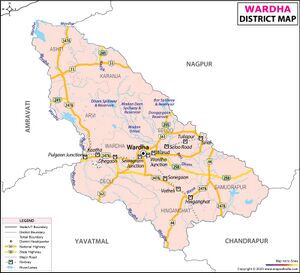

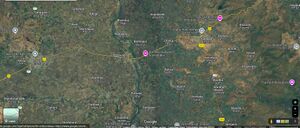
Belora (बेलोरा) is an ancient historical village in Ashti tahsil in Wardha district of Maharashtra.
Variants
Origin
Location
Belora Kh is a Village in Ashti Taluka in Wardha District of Maharashtra State, India. It belongs to Vidarbha region . It belongs to Nagpur Division . It is situated 18km away from sub-district headquarter Ashti. It is located 80 KM towards North from District head quarters Wardha. Belora (kh) Pin code is 442202 and postal head office is Ashti (Wardha). This Place is in the border of the Wardha District and Amravati District. Amravati District Tiwsa is South towards this place.[1]
Belora Bk is a Village in Ashti Taluka in Wardha District of Maharashtra State, India. It belongs to Vidarbha region . It belongs to Nagpur Division . It is situated 20km away from sub-district headquarter Ashti. It is located 80 KM towards North from District head quarters Wardha. This Place is in the border of the Wardha District and Amravati District. Amravati District Tiwsa is South towards this place .[2]
Jat Gotras Namesake
Belora Plates (Sets A and B) of 11th year of Pravarasena II
[p.16]: These plates were discovered in the possession of Mr. N. H. Jane of Belora, a village in the Arvi tahsil of the Wardha District, which is situated on the left bank of the Wardha River, about 6 miles south by east of Morshi. They were edited by me with facsimiles in the Epigraphia Indica, Vol. XXIV, pp. 260 f. They are edited here from the same facsimiles.
The four copper-plates obtained from the owner were, on examination, found to fall into two sets of two plates each, called hereafter Set A and Set B. Each set originally consisted of three plates, but the last plate of Set A and the first one of Set B are not forthcoming now. The first plate of Set A is inscribed on one side only, and all the other plates on both the sides. The plates of Set A are slightly larger in size and heavier in weight than those of Set B. The former measure 9.9" by 4.9", and weigh 67.1/2 tolas, while the latter measure 9.6" by 4.8" each, and weigh 64 tolas. About 2" from the middle of the proper right of each plate there is a round hole in diameter for the ring which originally held together the plates of each set, but neither the rings nor the seals which must have been connected with them are now forthcoming. All the plates are in an excellent state of preservation. The letters are deeply cut and some of them show through on the other side, especially in the case of the first plate. When carefully examined, the grants appeared to be palimpsests, all the plates showing here and there clear traces of earlier letters which were beaten in before the present charters were incised on them. These earlier letters were box-headed and of the same type as those which were later engraved in their place. So the earlier charters undoubtedly belong to the same period. As their letters have been almost everywhere carefully beaten in, it is not now possible to say who issued them, what they recorded and why they were cancelled.
As stated above, both the inscriptions are incomplete. The preserved writing of the first one, which has lost its concluding part, contains 18 lines, and that of the second, of which the initial portion is missing, 24 lines. The characters of both are of the boxheaded variety and resemble in a general way those of the other grants of Pravarasena II. The only peculiarity worth noticing is the use of the looped t. In both the sets, t appears in the looped and unlooped forms; for instances of the former, see yato- in line 14 of Set A and viditam- in line 17 of Set B, and for those of the latter, notice Shoḍashy-Atirātra- in line 1 of Set A and atīt- in line 25 of Set B. The subscript t is usually looped and to distinguish it from n its loop elongated; see e.g. Kārttayuga- in line 12 and bhukti in line 13 of Set A.
The language is Sanskrit. The existing portion of Set A is wholly in prose; that of Set B is also in prose except for two benedictive and imprecatory verses in lines 27-29. The orthography of both the sets shows the same peculiarities, viz., (1) the vowel ṛi is used for ri and vice versa; see pautṛiṇah and Prithivisenasya in line 9 of both the sets. In vishṛita, line 16 of Set B, the vowel ṛi is used for ru. (2) Similarly, li is used for the vowel ḷi in saklipt-opaklipa in line 22 of Set B. (3) The palatal ś is used for the dental 5 - in Śuryya- in line 14 of Set A. (4) The consonant following r and that preceding r and y are doubled; see e.g. abhivarddhamāna- in line 8 and sarvvādddhyaksha in lines 14-15 of both the sets and vikkrama in line 7 of Set A. Besides, both the sets show such mistakes as the use of the short for the long vowel, ungrammatical forms of words, etc.
[p.17]: Both the sets of plates were issued by Pravarasena II of the Vakataka dynasty. His genealogy is traced here from Pravarasena I exactly as in the preceding Jamb plates, his maternal grandfather Chandragupta II being called Devagupta. The plates of set A, the record on which begins with drishṭam, were issued from Nandivardhana. The place of issue in the case of those of Set B is unknown owing to the loss of its first plate.
The former record the grant of the village Mahalla-Lata in the Asi (असि) bhukti, which was situated in the mārga (subdivision) of Shailapura (शैलपुर), while the latter register the donation of two villages, viz.., Dīrghadraha in the Pākkanarāshtra and Mahallama-Laṭa. Of these latter villages, the second is plainly identical with the village Mahalla-Lata of Set A as it is specified exactly like it. The grant recorded in Set B is, therefore, later than that of Set A. The donee of both the grants was the same viz., Suryasvamin of the Kashyapa gotra and Taittiriya shaka, who was a resident of the place Pravareshvara-shaḍvimsati-vāṭaka. Both the grants were, again, made at the victorious place of religious worship (vaijayika-dharma-sthāna) for the increase of religious merit, life, strength, victory and fortune of the donor. The date of the first record is missing, but that of the second is given at the end. The latter was written, while Chitravarman was the Senapati, on the thirteenth tithi of the bright fortnight of Karttika in the eleventh regnal year.
As stated above, the second set of plates records the grant of two villages, one of which had already been given by the same king to the same donee by the first set. Why it was found necessary to include the village again in the second grant is not known. Cases of the issue of a fresh charter recording again a previously made gift are indeed not unknown; but in such cases the circumstances which necessitated the issue of a fresh charter such as a foreign invasion or the loss or damage of the earlier charter by fire etc., are generally specified.1 No such reasons are given in the present case. In fact, both the charters purport to have been granted by the same king and the interval between their dates could not have been more than ten years. This therefore raises the question if the second charter, or at least the second plate of it which records the grant of two villages, is a forgery2. In favour of such a supposition may be adduced the circumstance that the writing on the second plate of Set B begins and ends with the same words as that on the second plate of Set A, so that the former plate could have been easily substituted for the latter. It may, however, be pointed out that there are no other circumstances suggesting such a forgery. As shown above, both the plates of Set B are smaller in size than those of Set A so that not one but two plates must have been so substituted. But there was apparently no need to replace the third plate of the first grant. Again, the similar formation of letters and the occurrence of the same orthographical peculiarities and grammatical mistakes in both the records make it highly probable that both the grants were written by the same clerk in the Secretariat of the Vakatakas. The mention of Chitravarman as Sendpati in Set B is another point in favour of the genuineness of that set; for, from the Chammak plates of Pravarasena II we learn that Chitravarman held that office till at least the 18th year of
1 See e.g. the Barah copper-plate of Bhojadeva, Ep. Ind., Vol. XIX, p. 18, and the Nidhanpur copper-plates of Bhaskaravarman, ibid., Vol. XII, p. 76.
2 Dr. N. P. Chakravarti has suggested that the grant of two villages in Plate II of Set B was found to be wrong on examination and that this plate was meant to be replaced by Plate II of Set A which was subsequently engraved. He has drawn attention to the ornamental mark found after atisrishtah in Plate II of Set A, which, according to him, was intended to prevent any unauthorized addition in the blank space left at the end of that line. He has not, however, offered any satisfactory explanation for the circumstance that the unwanted plate was not removed or cancelled.
[p.18]: Pravarasena II's reign. The second set does not, therefore, appear to be spurious. The reason why it includes the name of a previously donated village seems to be that the Brahmana donee probably made a request to the king to give him a consolidated charter for the two grants.
As for the localities mentioned in the present grants,
Nandivardhana has already been shown to be identical with Nandardhan (or Nagardhan) near Ramtek in the Nagpur District.
Mahalla-Lata or Mahallama-Lata which seems to mean the larger Lata may be represented by Ladki (लाड़की) or Ghat Ladki (घाट लाड़की) in the Morshi taluka of the Amaravati District, about 18 miles north by west of Belora1 Mahalla-Lata lay in the mārga of Shailapura which may be identical with Salbardi (सालबर्ड़ी)2 situated in the midst of hills about 15 miles east of Ladki.
Asi (असि), the chief town of the bhukti (subdivision) in which Mahalla-Lata was situated, may be identical with Ashti which lies only 10 miles south of Belora.
Dirghadraha (दीर्घद्रह) is probably Dighi (दीघी) on the left bank of the Wardha, about 30 miles south of Ashti. The name of Pravareshvara-shaḍvimsativāṭa which is mentioned in both the grants as the home of the donee seems to indicate that it was the chief village in a group of twenty-six villages. Perhaps it received this name from a shrine of Shiva called Pravareshvara installed by Pravarasena I and named after himself3. This place as well as Pakkana (पाकण), the headquarters of the rāshtra (division) in which Dirghadraha, one of the donated villages, was situated, cannot be traced now.
1 There is another small village called Ladgaon (लाड़गांव) on the left bank of the Wardha, about 20 miles south of Belora.
2 Salbardi is an ancient place containing some old caves and hot springs.
3 Compare the name Vanko-Tummana of the first capital of the Kalachuris in Chhattisgadh (Ind. Hist. Quart., Vol. IV, p. 34). It was so called because of the shrine of Vankeshvara which it contained. It may be noted in this connection that the temple of Pravareshvara is mentioned in line 1 of No. 14, below.
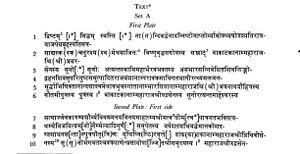
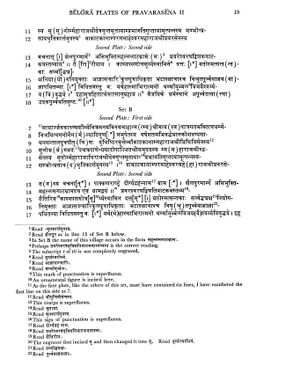
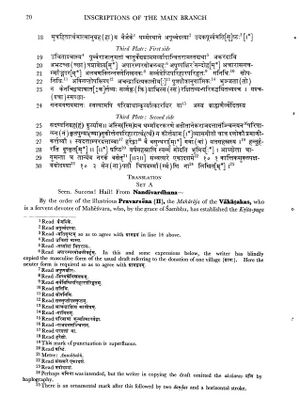
[p.20]: Seen. Success! Hail! From Nandivardhana —
By the order of the illustrious Pravarsena (II), the Maharaja of the Vakatakas, who is a fervent devotee of Maheshvara, who, by the grace of Shambhu, has established the Krita-yuga
[p.21]: (Golden Age) (on the earth), who was born of Prabhavatigupta, the daughter of the Maharajadhiraja, the illustrious Devagupta, and who is the son of the Maharaja, the illustrious Rudrasena II —
(Line 13). The village Mahalla-Lata (महल्ल लाट) in the Asi bhukti in the mārga of Shailapura (शैलपुर) has been donated (by Us) to Suryasvamm of the Kashyapa gotra and Taittiriya (shakha) who resides in the (village) Pravaresvara-shadvimsati-vatakah1
Wherefore, Our officials of noble birth, who are employed by the order of the Sarvādhyaksha (General Superintendent) and who exercise their authority by (Our) command, and (Our) Soldiers and Policemen should be directed by the (following) command which is already well-known (to them):—
“ Be it known to you that in order to increase Our religious merit, life, power, victory and prosperity, to secure Our well-being in this world and the next and to obtain blessings for Ourself, We have given (this village) as a gift not previously made, with the pouring out of water, in (Our) victorious place of religious worship.
(Line 12). By the order of the illustrious Pravarasena (II), the Maharaja of the Vakatakas,....
The two villages (viz.) the village named Dirghadraha (दीर्घद्रह) in the Pakkana (पाकण) rāshtra and the village Mahallama-Lata (महल्लम लाट) in the Asi bhukti in the mārga of Shailapura (शैलपुर), have been donated (by Us) to Suryasvamin of the Kashyapa gotra and the Taittiriya shakha, who resides in the Pravareshvara-shadvimsati-vataka.
(Line 26). And the following two verses sung by Vyasa should be regarded as an authority on this point: —
(Line 29). (This charter) was written by [Mani], Chitravarman being the Senāpati, on the thirteenth— 10 (and) 3 — (lunar day) in the bright fortnight of Karttika in the eleventh — 10 (and)1 — (regnal) year.
1 This seems to be a territorial division of twenty-six villages named after a shrine in honour of Shiva under the name of Pravareshvara, apparently built by Pravarasena I. See below, p. 63.
Wiki editor Notes
- Asiagh (असिहाग) (Jat clan) → Asi (असि) = Ashti (आष्टी) is a town and tahsil in Wardha district of Maharashtra. Its ancient name was Asi (असि) mentioned in Belora Plates (Sets A and B) of 11th year of Pravarasena II.[3]
- Belora - Belora is also name of villages in Chandurbazar, Daryapur Amravati, Nandgaon-Khandeshwar tahsils of Amravati district.
- Dighi - Dighi named Villages are in Arvi or Deoli Wardha (Wardha) or Daryapur Amravati tahsil of Amravati, MS
- Dighi Mahalle - Village in Dhamangaon Railway tahsil of Amravati, MS
- Dighi Kolhe - Village in Chandur Railway tahsil of Amravati, MS
- Ghat Ladki - Village in Chandurbazar tahsil of Amravati, MS
- Dighalia (डीघलिया) (Jat clan) → Dighi (दीघी) = Dirghadraha (दीर्घद्रह) mentioned in Belora Plates (Sets A and B) of 11th year of Pravarasena II[4] Dighi (दीघी) is a village in Arvi tahsil of Wardha district in the Maharashtra.
- Mahala (महला) (Jat clan) → Mahalla-Lata (महल्ल लाट) or Mahallama-Lata (महल्लम लाट) which seems to mean the larger Lata may be represented by Ladki (लाड़की) or Ghat Ladki (घाट लाड़की) mentioned in Belora Plates (Sets A and B) of 11th year of Pravarasena II.[5]Ladki (लाड़की) is a village in Morshi tahsil of Amravati district in Maharashtra.
- Pakkana (पाकण) - Mentioned as a Pakkanarashtra (पाकणराष्ट्र) could not be identified.
- Shail (शैल) (Jat clan) → Salbardi (सालबर्ड़ी) identified with Shailapura (शैलपुर) mentioned in Belora Plates (Sets A and B) of 11th year of Pravarasena II.[6]Salbardi (सालबर्ड़ी) is a village in Morshi tahsil of Amravati district in Maharashtra.
History
Notable persons
Gallery
External links
References
- ↑ https://www.onefivenine.com/india/villages/Wardha/Ashti/Belora(kh)
- ↑ https://www.onefivenine.com/india/villages/Wardha/Ashti/Belora(bk)
- ↑ Corpus Inscriptionum Indicarum Vol.5 (inscriptions Of The Vakatakas), Edited by Vasudev Vishnu Mirashi, 1963, Archaeological Survey of India, p.16-21
- ↑ Corpus Inscriptionum Indicarum Vol.5 (inscriptions Of The Vakatakas), Edited by Vasudev Vishnu Mirashi, 1963, Archaeological Survey of India, p.16-21
- ↑ Corpus Inscriptionum Indicarum Vol.5 (inscriptions Of The Vakatakas), Edited by Vasudev Vishnu Mirashi, 1963, Archaeological Survey of India, p.16-21
- ↑ Corpus Inscriptionum Indicarum Vol.5 (inscriptions Of The Vakatakas), Edited by Vasudev Vishnu Mirashi, 1963, Archaeological Survey of India, p.16-21

